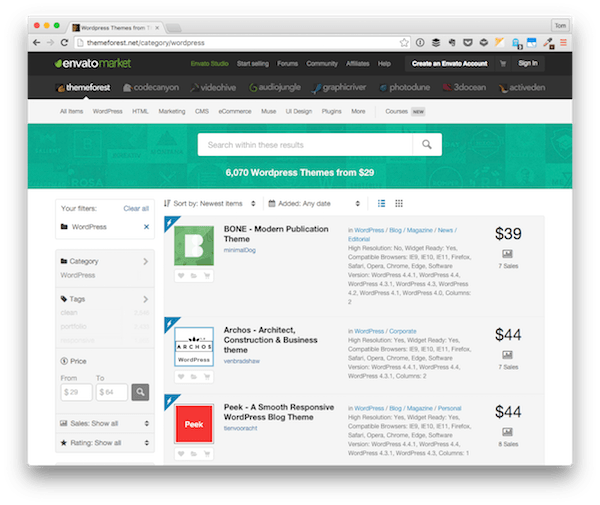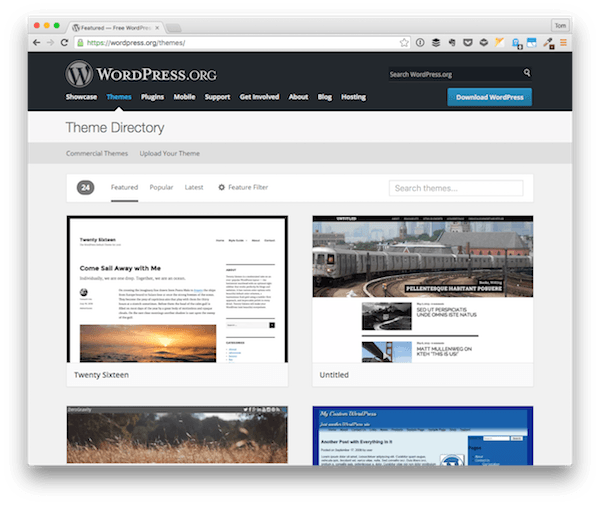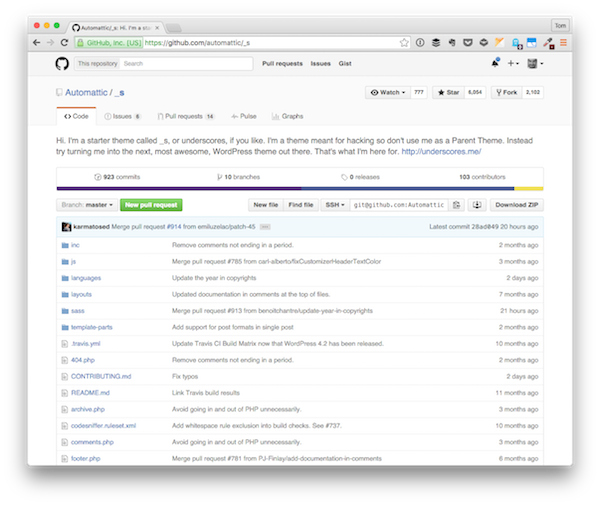We recently wrapped up a series that covered How to Get Started With WordPress. Though it’s not a pre-requisite for reading the following article, I recommend reading through the four posts, especially if you’re someone who is just now getting started with WordPress.
The people who visit Envato Tuts+ come from a variety of backgrounds, both in terms of their culture and in terms of their experience. Oftentimes, we publish articles that are geared towards those who have some level of experience with development even if it’s not in the field they are researching.
I’d argue that once you’re familiar with concepts in one language or in one field, you can use those skills to translate your work into another language or into another platform.
But what if you’re absolutely brand new to a topic and you’re looking for somewhere to start? That’s what the aforementioned series and the following article aim to answer.
To that end, if you’re new to WordPress and are looking to get your bearings, then check out How to Get Started With WordPress and continue your journey following along as we answer the question: What are WordPress themes?
A Presentation for Your Site
Before we begin an in-depth discussion of themes, I want to say that I like to think of themes as the presentation of your site. That is, your site or your blog is nothing more than posts, pages, categories, and other things, all of which are stored in a database.
Sure, you can render them in the browser without any styling whatsoever, but if you have a brand or a look and feel that you’re aiming to achieve, not having a theme is not going to communicate any of that to your visitors and/or your readers.
But that’s my definition. How does WordPress define “a WordPress theme”? In the Codex, we find the following:
Fundamentally, the WordPress Theme system is a way to “skin” your weblog. Yet, it is more than just a “skin.” Skinning your site implies that only the design is changed. WordPress Themes can provide much more control over the look and presentation of the material on your website.
There’s more to read, so I recommend reading the document in its entirety, but for the purpose of this article, we have a definition from which we can work.
How Much Does a Theme Cost?
This is a very common question, and it’s one that has both its advantages and disadvantages.
Free Themes
On one hand, you can find many, many good-looking themes for free; however, many of the themes that are free are also a bit more generic. Further, because they are free, it’s likely that other people are going to have the same theme.
If you’re setting up a blog for yourself that will reach a small audience, or you’re looking to set up a site that doesn’t need to have a unique form of branding, then using a free solution is completely fine.
Paid Themes
On the other hand, some themes can cost anywhere from $1,000 to $20,000 and upwards depending on the level of design and customization, requirements, and environment that go into supporting them.
If that sounds like an outlandish amount of money to spend on a theme, remember that we’re talking about software that is going to power a website that may be used by many, many, many people.
There are a lot of considerations that come with a solution like this.
Where Do I Find Them?
There are a number of places online that have themes available; however, not all places are worth searching. In fact, there are only a handful of reputable places that I recommend. Not all of them will be covered below, but two of the best places that can be referenced are below.
Additionally, I’ll also talk a bit about why we should avoid looking for free themes just anywhere and stick to premium marketplaces.
ThemeForest

ThemeForest is Envato’s own marketplace which features, at the time of this writing, over 6,000 WordPress themes.
The themes that you’ll find in this marketplace will range anywhere from specialty themes that aim to do one thing and do it well to themes that will try to do everything that you can imagine.
Though the WordPress community stays divided over just how much a theme should actually do for the user, the decision is ultimately with the consumer on how much they want their product to do.
Given that themes that offer a variety of options continue to sell, it shows that there is a market for them. However, there’s also something to be said for niche themes that stay focused on one thing and continue to improve on a single niche of the blogging and/or content management space.
WordPress Theme Repository

The WordPress Theme Repository is an official repository that allows theme developers to submit their work, undergo a bit of a review process, and then have their products made available for download both from the website and from the WordPress dashboard.
These themes tend to be more focused on doing one thing really well. For example, you’re likely to find themes that focus specifically on blogging, photography, music, or showcasing some other aspect of a hobby.
If you’re just getting into exploring WordPress themes and are looking to do so without a budget, then the WordPress theme repository is a great place to start.
Are There More?
There are absolutely more theme marketplaces than those listed above, but if we aimed to capture all of them then we’d have an article that would take days to read. Instead, I’ve tried to capture two of the most popular places to find premium and free themes.
To be sure, this is not a comprehensive list, and you can always hire a developer on your own. Furthermore, if you spend enough time learning the ins and outs of theming, perhaps you can build one yourself.
We’ll be talking about that momentarily, but first I want to mention a few words about free themes that are returned in your average Google search result.
The Dangers in Searching for Themes
Remember, though, if you’re just getting into WordPress theming, this is something that will come with experience rather than something that you need to worry about this point in time.
When it comes to WordPress themes, the Internet is replete with resources on where to find them.
But, a very, very strong word of caution: If you opt to navigate to Google and search for free WordPress themes, then you’re setting yourself up for danger.
That is, many of the free themes that you’re likely to find on Google have not been vetted by the proper sources and may end up leaving your site vulnerable.
Obviously, that’s no good. To that end, stick with some of the reputable marketplaces like those listed above, as those are ideal for acquiring a theme.
How Do I Build My Own Themes?
For those who find an interest in designing WordPress themes, one of the logical questions that comes next is: “How do I build my own themes?”
And this is a great question if for no other reason than because it shows other people are looking to learn a new skill and to contribute something to the WordPress economy.
With that said, it does require a bit of a learning curve. First, it’s important to recognize that you’ll need to know a handful of languages of development. These include:
Furthermore, you’ll need to know how to work with a web server and a database. Though you may not need to communicate directly with the database, it helps to know how information is transferred from what you see in WordPress and back to what you see on your screen.
Luckily, there are plenty of resources available for learning exactly this. Envato offers the following material:
And for those who are looking for more advanced topics, we have other courses on that, as well.
Alternatively, it’s also useful to study code that’s managed by an entire team of open source contributors. That’s what the Underscores project is all about.

Directly from the project’s repository:
Hi. I’m a starter theme called _s, or underscores, if you like. I’m a theme meant for hacking so don’t use me as a Parent Theme. Instead try turning me into the next, most awesome, WordPress theme out there.
In other words, Underscores is a theme that serves not only as a starter theme or a base theme from which you can build your own work, but also as a theme that works well as a case study in how various templates should be built, how directories should be organized, how source code should be written, and so on.
What About Functionality?
When it comes to talking about functionality in the context of WordPress themes, you’re starting to mix the ideas of presentation with, well, functionality. And that’s where WordPress plugins come into the picture.
The core of WordPress is designed to be lean and lightweight, to maximize flexibility and minimize code bloat. Plugins then offer custom functions and features so that each user can tailor their site to their specific needs.
Generally speaking, WordPress themes should be responsible for managing the presentation of your website. That is, they are responsible for the fonts, color scheme, and the layout of the site.
Plugins, on the other hand, are responsible for introducing functionality that extends the core features of WordPress. Perhaps they introduce a feature unique to your blog, or perhaps they enhance something that your blog didn’t previously have in the dashboard.
Whatever the case, there should be a strict line that exists between themes and plugins. Unfortunately, this line is often crossed. Instead, you find many themes bundling plugins with their source code such that the theme does not function without the plugin. Furthermore, if a user goes to install a version of the plugin that’s already bundled with the theme, then this could have erratic results with their site.
Though I’m not making the claim that you should never build a theme with any enhanced functionality, I’m personally of the mindset that themes should be responsible for presentation, and plugins should be responsible for functionality.
With that said, and as outlined earlier in this article, there is a market for themes that tend to “do it all”, and it’s evident by products that are sold and purchased in a variety of marketplaces.
The best advice I can give in the context of creating WordPress themes is to focus on making sure it’s presenting and styling information properly. From there, you can venture into plugin development. But that’s another topic for another time.
Conclusion
Understanding what WordPress themes are and the purpose they serve is relatively easy, but if you’re looking to build your own then that’s an entirely different venture. It takes a level of understanding of a number of programming languages, and it takes an understanding of things such as the WordPress template hierarchy.
Luckily, we have some great courses on this. On top of that, we also have plenty of material in the marketplace that’s available for you to download, to study, and to use in your day-to-day work.
If that’s not enough, there’s plenty of documentation and open-source code available for you to review and read, as well.
For those who continue to be interested in WordPress, note that I exclusively work with WordPress and often write about it. You can catch all of my courses and tutorials on my profile page, and you can follow me on my blog and/or Twitter at @tommcfarlin where I talk about software development in the context of WordPress.
Don’t hesitate to leave any questions or comments in the feed below, and I’ll aim to respond to each of them.